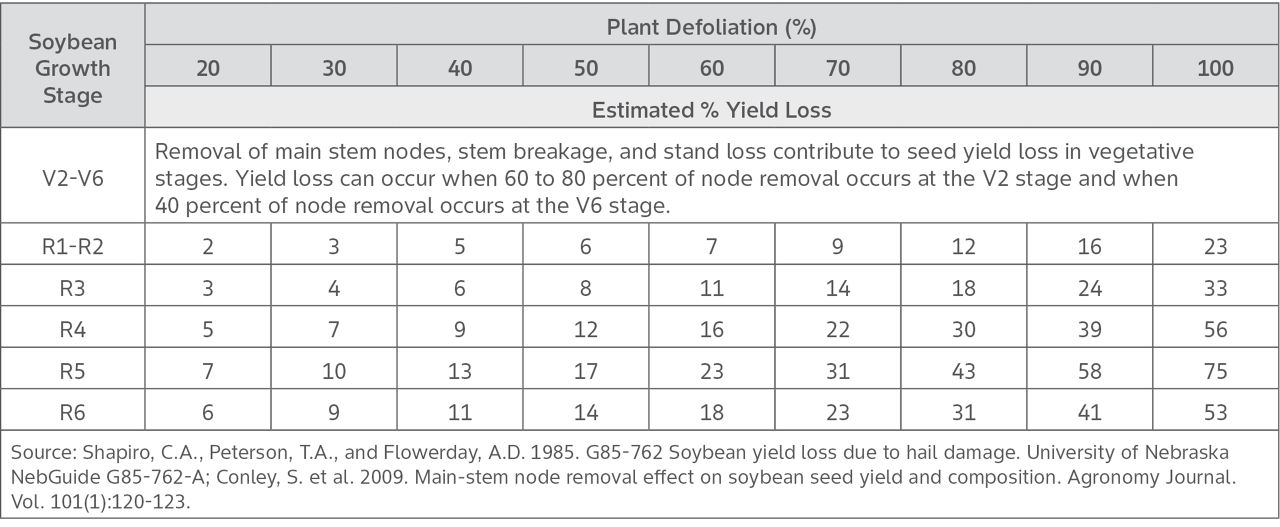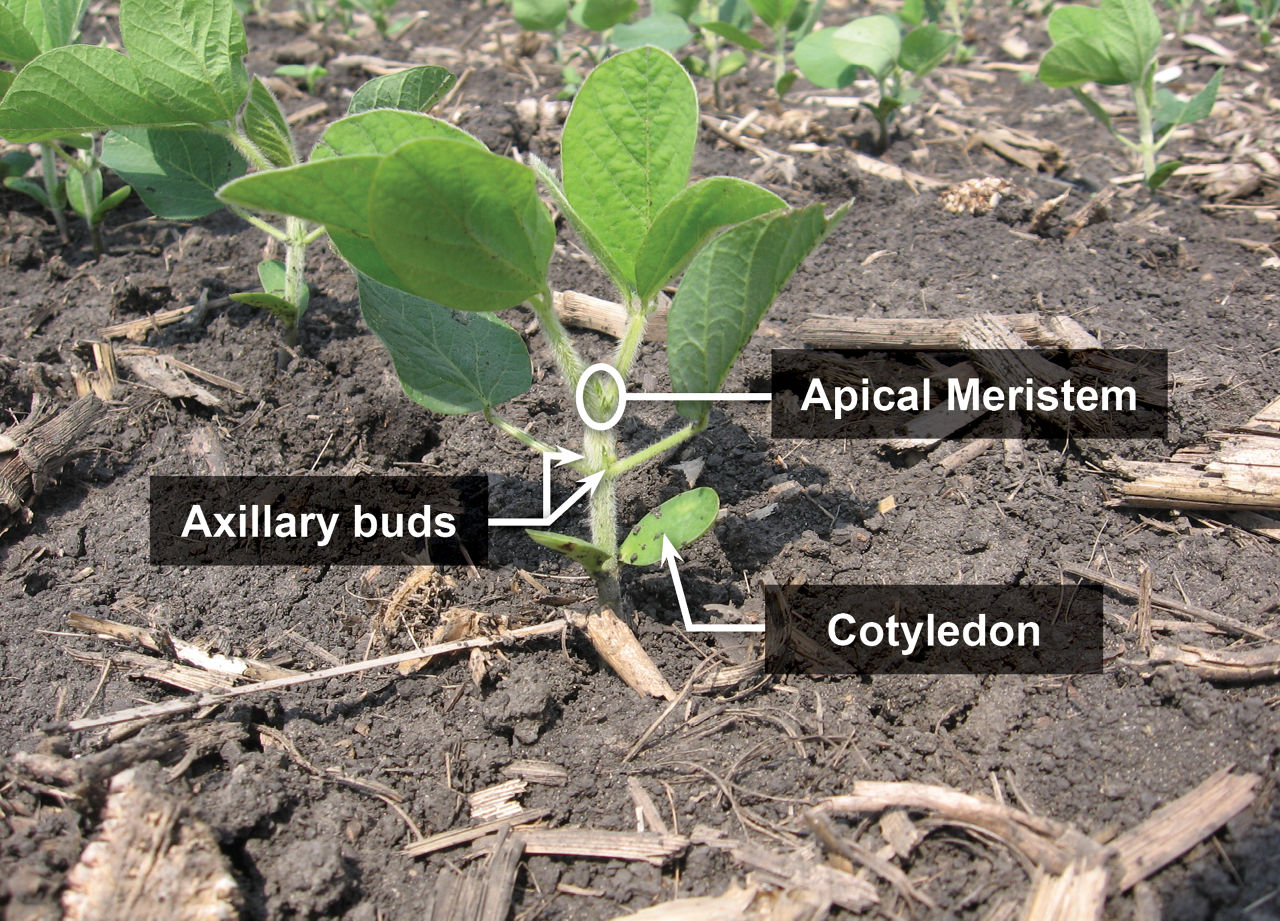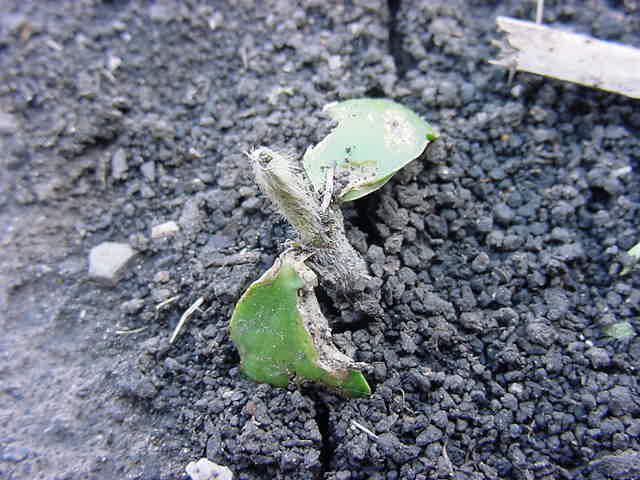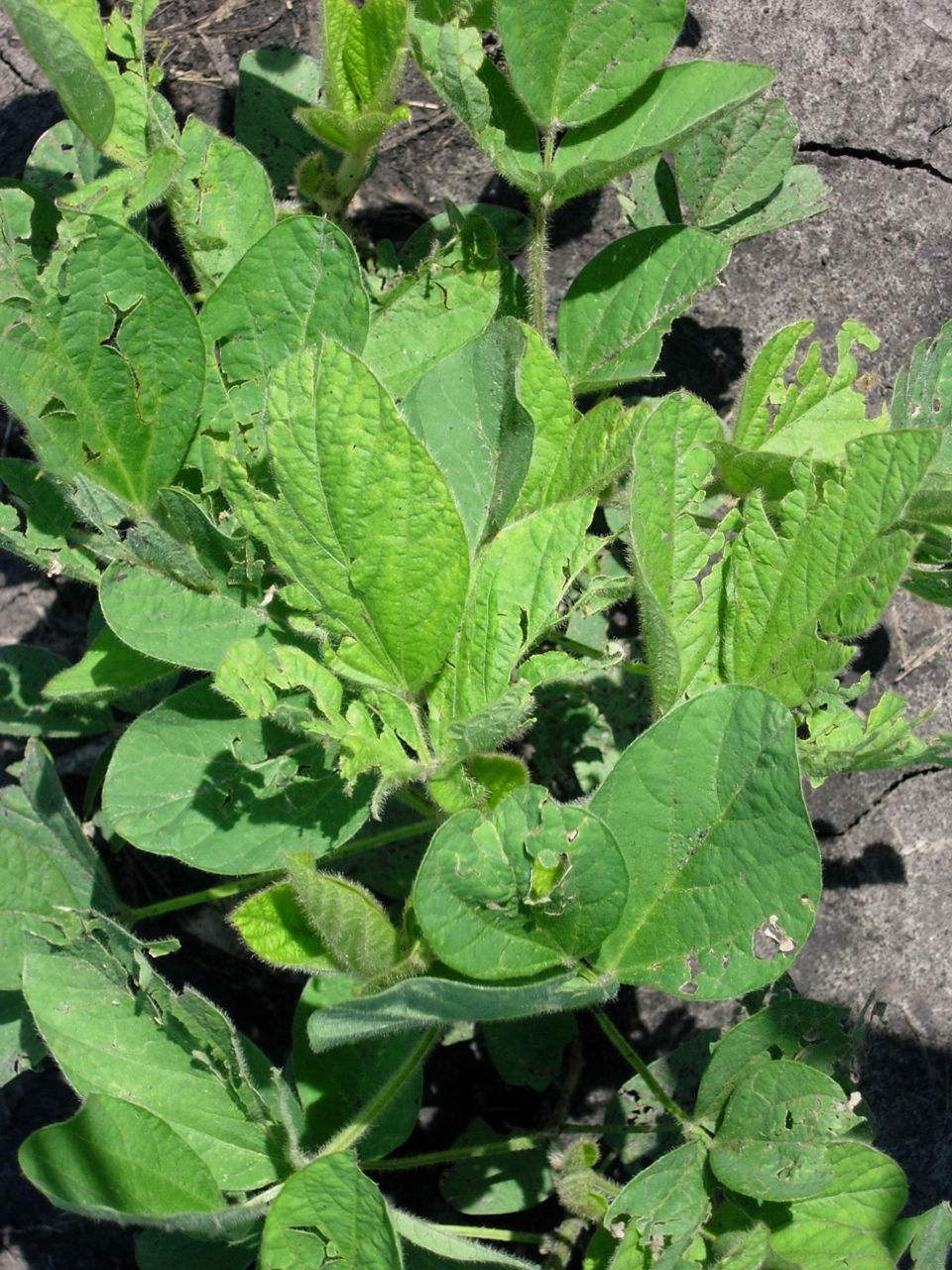Recovery and Assessment of Hail Damaged Soybean
June 30, 2025
A hail event can result in defoliation, stand reduction, stem bruising, and the loss of terminals or pods and yield potential loss to soybean. It is important to accurately assess the severity of each of these factors and determine the extent of hail damage, and how yield potential will likely be affected. Depending on the timing and growth habit of soybean, there is a good chance for soybean plants with growing points still intact to make a full recovery.
Regrowth on soybean after hail can usually be seen within four to seven days after the storm, depending on weather conditions, so evaluation of the growing point can be completed by that time. However, it is recommended to wait from seven to ten days post-storm to more accurately assess yield potential, based on the remaining stand of healthy plants.1 At this time, it should be easier to accurately distinguish between viable plants and those unable to withstand the hail damage itself or subsequent disease development.
Defoliation
If the soybean crop was damaged before flowering, plants may not be significantly affected by loss of leaf area (Table 1). Soybean plants in vegetative growth stages have an extraordinary ability to compensate for damaged leaves, defoliation, or reduced stands by branching out. If recently emerged soybean plants are cut off below the cotyledons, the plant will not survive. If either the apical meristem (growing point at the top) or axillary buds (located at the juncture of the stem and leaves) remain intact after the hail event, new branches and leaves can be produced even though the hail may have destroyed nearly all of the above-ground foliage (Figures 1 and 2). Leaves that have been shredded by a hailstorm can conduct photosynthesis and contribute to continued growth as long as the leaf tissue remains green (Figure 3).2,3
Table 1. Estimated soybean yield loss from plant defoliation.




Estimating Potential Yield Loss Due to Stand Reduction
Because soybean plants have the ability to recover by branching out after a hail event, potential yield loss from stand reduction during early growth stages is not of major concern. If severe stand losses occur, replanting may be an option. Fields with a uniform stand of 90,000 to 100,000 plants per acre may achieve nearly full yield potential. For example, if the pre-storm plant stand was 125,000 plants per acre, and after the storm the number of viable plants per acre was down to 100,000 (20% reduction) a yield loss of about 6% could be expected. If the stand was reduced to 70,000 plants per acre (a 56% reduction), yield loss could be about 18%.1 In general, if at least two-thirds of the original stand remains, it is probably best to keep it and not consider replanting.4 Please note that these yield loss estimates are valid only for vegetative growth stages, or prior to flowering. During reproductive stages, however, for each percent of stand loss, expect approximately an equal amount of yield loss.1,2,3
Stand loss from hail can often leave “gaps” in the stand. While uniformity of stand is important, gaps of less than two feet can be compensated for by adjacent soybean plants by developing branches. Gaps greater than two feet might contribute to yield loss.5
Loss of Terminals or Pods
Hail damage that causes the loss of terminal buds can reduce the number of locations where a pod can develop, which then reduces the number of pods that a plant can produce. This reduction in pods directly lowers the yield potential of that plant. The amount of damage is dependent on the crop growth stage at the time of the hail event and the amount of time left in the growing season for the crop to regrow additional terminals. Once a soybean plant reaches the R6 growth stage, it can no longer compensate by producing additional flowers or branches.4 Pods that are directly removed from the plant by hail will reduce yield. Four beans per square foot on the ground equals a yield loss of about one bushel per acre.
Stem Damage
Bruises from hail on the lower stem can lead to lodging later in the growing season and result in harvest losses. Stem bruising is also a potential avenue for infection, which can affect plant health and productivity.
Estimating Yield Loss
The University of Nebraska developed a worksheet, Evaluating Hail Damage Loss to Soybeans, that takes into account growth stage, stand reduction, defoliation and stem damage for calculating actual yield loss.
Should I Apply a Fungicide After Hail?
Growers should scout for bacterial diseases, stem rot, and other foliar diseases after a hail event.6 Poor environmental conditions during the remainder of the growing season can promote the development of diseases and result in additional lodging, leading to more harvest losses. While a fungicide application cannot recover yield potential lost due to hail damage, a fungicide application can help increase the plant's stress tolerance after a hail event. Delaro® 325 SC fungicide delivers long-lasting residual control from both its strobilurin and triazole components for extended performance from each active ingredient against important foliar diseases. Plus, the dual modes of action from Delaro® 325 SC fungicide help ensure you're not promoting further disease-resistance development. To learn more about Delaro® 325 SC Fungicide, visit https://www.cropscience.bayer.us/products/fungicides/delaro and contact your local retailer.
Additionally, soybean fields should be scouted for lodging due to weakened stems and rot. Late-season weed flushes can also be a concern due to increased light penetration in defoliated areas. Expected yield loss figures due to damaged or missing plants are only estimates. True yield loss from a hailstorm cannot be fully determined until harvest.
Sources
1 Klein, R. and Shapiro, C. 2011. Evaluating hail damage to soybeans. EC128. https://extensionpubs.unl.edu/publication/ec128/2011/pdf/view/ec128-2011.pdf
2 Anderson, E. 2022. Assessing hail damage to soybeans in the early vegetative stages. Michigan State University. https://www.canr.msu.edu/news/assessing_hail_damage_to_soybeans_in_the_early_vegetative_stages
3 Coulter, J., Naeve, S., and Nicolai, D. 2018. Hail damage to soybean crops. University of Minnesota Extension. https://extension.umn.edu/growing-soybean/hail-damage-soybean-crops#estimating-yield-loss-1096560
4 Ciampitti, I. and Roozeboom, K. 2014. Assessing hail damage on soybeans. Kansas State University. Agronomy eUpdates, Issue 459. https://eupdate.agronomy.ksu.edu/article/assessing-hail-damage-on-soybeans-459-2
5 Whigham, K., Farnham, D., Lundvall, J. and Tranel, D. 2000. Soybean replant decisions. Iowa State University. https://store.extension.iastate.edu/Product/5422
6 No-Till Farmer. 2016. Fungicide use on hail damaged corn and soybeans. Sourced from North Dakota State University. https://www.no-tillfarmer.com/articles/5905-fungicide-use-on-hail-damaged-corn-and-soybeans
Web sources verified 06/05/2025. 1322_125375